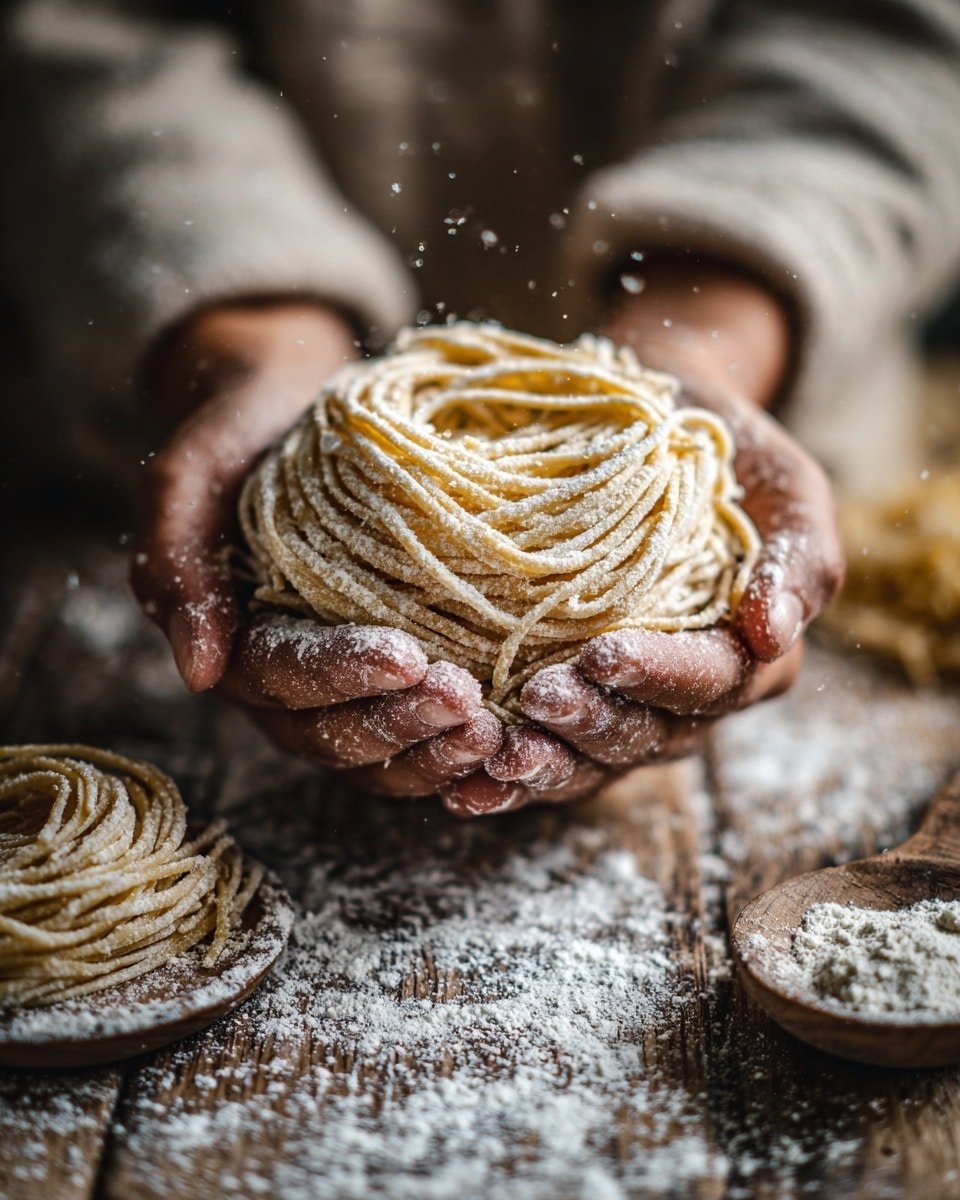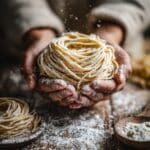How to Make Fresh Homemade Pasta – Hand Cut, No Machine Needed!
Making fresh homemade pasta by hand is one of the most rewarding and rustic culinary experiences you can try. With just a few ingredients—flour, eggs, and a bit of love—you’ll create soft, silky, delicious noodles that beat boxed pasta every time. No pasta machine required—just your hands, a rolling pin, and a sharp knife.
Whether you’re exploring easy homemade noodles, searching for a foolproof pasta dough recipe, or adding a new skill to your homemade cookbook, this step-by-step guide will walk you through the classic Italian pasta-making method, all by hand.
Why Make Pasta by Hand?
-
No fancy tools needed – just a rolling pin and a knife
-
It’s fun, meditative, and rewarding
-
Better texture than store-bought pasta
-
You control the thickness and shape
-
Perfect for rustic dishes and fresh pasta recipes
This method works for fettuccine, tagliatelle, pappardelle, and even lasagna sheets.
Ingredients Overview: Traditional Pasta Dough
All-Purpose Flour
-
Easy to work with and gives soft, tender noodles
-
You can also use 00 flour for a silkier texture or mix the two
Eggs
-
Provide richness, moisture, and structure
-
Large eggs work best
-
For egg-free dough, see variation below
Salt
-
Boosts flavor subtly in the dough
Olive Oil (Optional)
-
Adds elasticity and a little fat, making the dough easier to roll
Water (If Needed)
-
Only add if your dough feels too dry after mixing
Classic Ratio for Homemade Pasta
-
2 cups all-purpose flour
-
3 large eggs
-
½ tsp salt
-
Optional: 1 tsp olive oil
This makes about 3–4 servings of fresh pasta.
Step-by-Step Instructions: Hand-Cut Homemade Pasta
1. Make a Flour Well
-
Pour 2 cups of flour onto a clean countertop or large cutting board
-
Use your hands to create a deep well in the center
-
Crack 3 eggs into the well
-
Add ½ tsp salt and 1 tsp olive oil (optional)
2. Mix the Dough
-
Use a fork to gently whisk the eggs, gradually pulling in flour from the edges
-
Keep mixing until it becomes too thick for the fork
3. Knead the Dough
-
Use your hands to bring the dough together into a shaggy ball
-
Begin kneading—pressing with the heel of your hand, folding, and turning—for 8–10 minutes
-
The dough should become smooth and elastic
-
If too dry, add water a teaspoon at a time; if too sticky, dust with more flour
4. Rest the Dough
-
Wrap in plastic wrap or cover with a bowl
-
Let rest at room temperature for 30–45 minutes
-
This allows the gluten to relax, making rolling easier
5. Roll the Dough
-
Unwrap and cut dough into 2–4 smaller pieces
-
Lightly flour your surface and rolling pin
-
Roll one piece at a time into a thin rectangle (1–2 mm thick)
-
Turn the dough often to keep it from sticking
6. Cut the Pasta
-
Lightly dust the sheet with flour, then roll it loosely into a log
-
Use a sharp knife to cut into:
-
1/4 inch strips for fettuccine
-
1/2 inch for pappardelle
-
Or thinner for tagliatelle
-
-
Unroll noodles and toss gently with flour to prevent sticking
7. Cook the Pasta
-
Bring salted water to a boil
-
Drop in the pasta and cook for 2–3 minutes
-
Fresh pasta cooks much faster than dried
Serve with your favorite sauce—garlic butter, tomato basil, alfredo, or simply olive oil and parmesan.
Tips & Tricks for Success
-
Resting the dough is key to smooth, elastic pasta
-
Roll as thinly and evenly as possible for consistent cooking
-
If you’re in a humid climate, you may need less water or more flour
-
Dust cut pasta with flour if you’re not cooking immediately
-
You can freeze fresh noodles for up to 1 month
Variations and Substitutions
Semolina Flour Dough (Egg-Free)
-
1 cup semolina flour
-
1 cup all-purpose flour
-
¾ cup warm water
-
1 tsp olive oil
Mix and knead as above. Great for thicker cuts like orecchiette or hand-rolled pici.
Herbed Pasta
-
Add chopped basil, parsley, or spinach purée into the dough
Flavored Pasta
-
Add roasted beet, spinach, or carrot purée for colorful doughs
-
Add squid ink or turmeric for a dramatic visual twist
Perfect for…
This hand-cut pasta works beautifully for:
-
Classic Italian sauces like marinara, pesto, or carbonara
-
Hearty meat sauces (ragù or Bolognese)
-
Butter or olive oil-based sauces with herbs and cheese
-
Layered lasagna sheets—just roll thinner and cut to fit your pan
Also a great weekend kitchen project or cooking activity with kids.
Nutrition & Health Notes
Homemade pasta is:
-
Fresher and less processed than boxed pasta
-
Contains no additives or preservatives
-
Rich in protein (from eggs)
-
Can be made with whole wheat flour or gluten-free blends for dietary needs
Estimated Nutrition (per serving, ¼ of batch):
-
Calories: ~310
-
Protein: ~11g
-
Carbs: ~50g
-
Fat: ~7g
-
Fiber: ~2g
FAQ: Homemade Pasta Without a Machine
1. Can I make pasta without a machine?
Absolutely. This recipe is made to be rolled and cut by hand with just a knife and rolling pin.
2. How do I prevent sticking?
Lightly flour your dough as you roll and after cutting the noodles. Toss the strands gently with flour before storing or cooking.
3. Can I freeze fresh pasta?
Yes! Dust with flour, place in nests or layers, and freeze in airtight bags for up to 1 month.
4. Can I dry homemade pasta?
Yes, let the noodles air-dry in a single layer on a floured towel or pasta rack for several hours. Store in a sealed container for 2–3 weeks.
5. Why does my dough feel tough?
It may be too dry or under-kneaded. Add a little water and knead for another few minutes until it softens.
6. How thin should I roll the pasta?
As thin as possible—ideally 1–2mm. The dough will puff slightly during cooking.
7. Can I use gluten-free flour?
Yes, use a blend specifically made for pasta or substitute with almond flour + xanthan gum. The dough will be more delicate, so roll gently.
How to Make Fresh Homemade Pasta – No Machine Needed
A classic homemade pasta recipe using only flour, eggs, and salt—no pasta machine required. This hand-rolled and hand-cut pasta is soft, silky, and ready to pair with any sauce.
- Prep Time: 15 minutes
- Cook Time: 30 minutes
- Total Time: 45 minutes
- Yield: 4 servings 1x
Ingredients
-
2 cups all-purpose flour (or 1½ cups AP + ½ cup 00 flour)
-
3 large eggs
-
½ tsp salt
-
1 tsp olive oil (optional)
-
Water as needed
-
Extra flour, for dusting
Instructions
-
Make a flour well on a clean surface. Add eggs, salt, and oil in the center.
-
Whisk eggs and gradually mix in flour. Knead for 8–10 minutes until smooth.
-
Wrap dough and rest for 30–45 minutes.
-
Divide dough, roll into thin sheets with a rolling pin.
-
Dust with flour, roll up, and slice into desired widths.
-
Unroll noodles, toss with flour, and cook in boiling water for 2–3 minutes.
-
Serve with sauce of choice.
Notes
-
For egg-free, use semolina + water dough
-
Freeze pasta in floured nests for later use
-
Add herbs or spinach purée for variety

